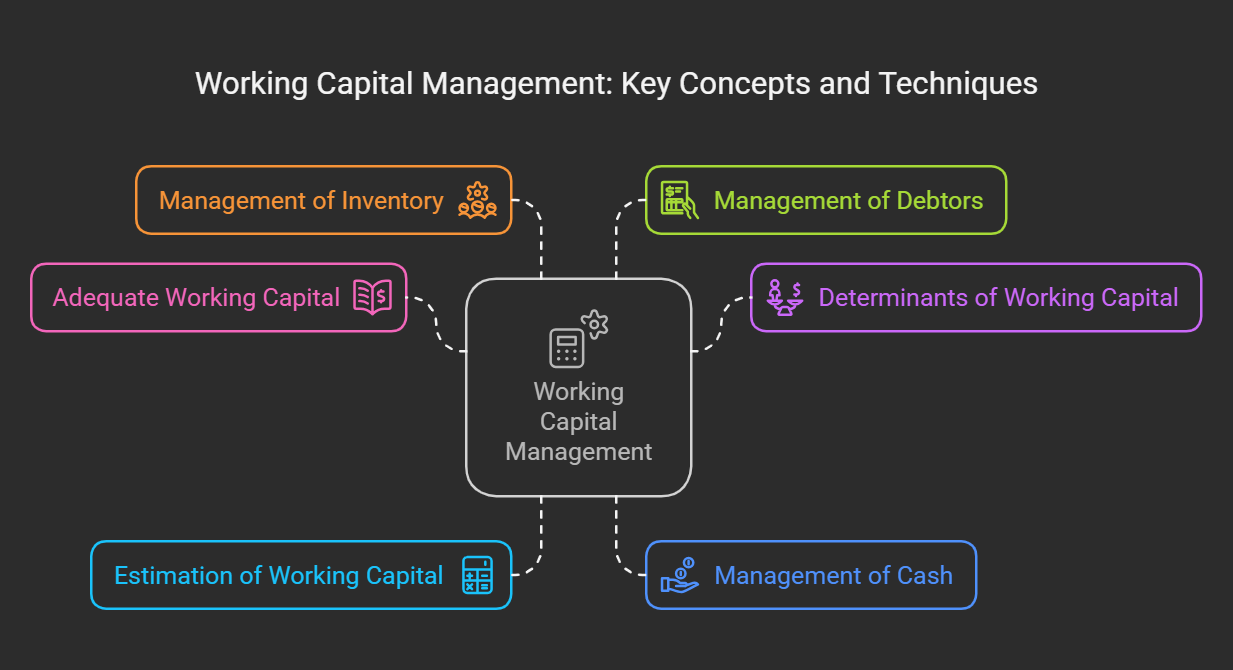advantages of working capital , determinants of working capital , estimation of working capital , management of cash
Working Capital Management Notes
IV. Adequate Working Capital
Definition: Optimal level of current assets to operate smoothly, meet obligations, and seize opportunities.
Consequences of Inadequate Working Capital:
- Inability to pay bills (penalties, credit damage).
- Missed opportunities.
- Inventory shortages (lost sales).
- Reliance on expensive short-term financing.
- Possible insolvency.
Consequences of Excessive Working Capital:
- Idle funds (missed investment opportunities).
- High inventory holding costs.
- Risk of obsolescence/damage.
- Inefficient resource use.
- Lower ROI.
Determining Adequacy:
-
Ratios:
- Current Ratio (Current Assets / Current Liabilities)
- Quick Ratio (Quick Assets / Current Liabilities)
- Cash Flow Forecasting: Project future inflows/outflows.
- Industry Benchmarks: Compare to industry averages.
- Operational Analysis: Evaluate inventory, receivables, and payables management.
V. Determinants of Working Capital
Factors influencing working capital needs:
- Nature of Business: Manufacturing vs. Service (Manufacturing requires more). Seasonal businesses.
- Size of Business: Larger companies need more.
- Production Cycle: Longer cycle = more work-in-progress inventory.
- Credit Policy: Liberal credit increases receivables.
- Inventory Turnover: Low turnover = more tied up in inventory.
- Availability of Credit: Easier access reduces cash balance needs.
- Operating Efficiency: Efficient operations reduce needs (e.g., JIT).
- Inflation: Higher costs may require more capital.
- Growth Rate: Rapid growth often needs more capital.
- Business Cycle: Expansions increase needs, recessions decrease.
- Technology: Improvements reduce needs.
- Profit Margins: High margins may reduce needs.
- Price Level Changes: Increased material and labor costs require more.
VI. Estimation of Working Capital
- Based on calculating current assets and liabilities.
-
Key Inputs:
- Projected Sales
- Production Cycle
- Credit Terms (to/from suppliers & customers)
- Operating Expenses
- Contingency (safety margin)
VII. Management of Cash
Objective: Sufficient cash to meet obligations, minimizing holding costs.
Techniques:
- Cash Budgeting: Forecast inflows/outflows.
- Cash Collection Management: Speed up collections.
- Cash Disbursement Management: Optimize payment timing.
- Investment of Surplus Cash: Short-term marketable securities.
- Electronic Funds Transfer (EFT): Speed up transactions.
- Lockbox System: Accelerate payment collection.
- Zero Balance Account (ZBA): Transfer funds only when needed.
- Concentration Banking: Centralize cash management.
VIII. Management of Inventory (Theory Only)
Objective: Optimal inventory level, meet demand, minimize holding costs.
Techniques:
- Economic Order Quantity (EOQ): Optimal order size.
- Just-in-Time (JIT) Inventory: Materials arrive just in time for production.
- Materials Requirement Planning (MRP): Planning material requirements based on schedules.
- ABC Analysis: Classify inventory by value (A, B, C).
- Vendor-Managed Inventory (VMI): Suppliers manage inventory.
- Perpetual Inventory System: Continuous record of inventory.
- Periodic Inventory System: Physical counts at intervals.
IX. Management of Debtors (Accounts Receivable) - (Theory Only)
Objective: Collect payments quickly, minimize bad debt risk.
Techniques:
- Credit Policy: Clear terms and procedures.
- Credit Analysis: Assess creditworthiness.
- Invoice Management: Prompt and accurate invoicing.
- Collection Procedures: Follow up on overdue accounts.
- Discounts for Early Payment: Incentives for early payment.
- Factoring: Sell receivables at a discount.
- Securitization: Bundle and sell receivables to investors.
- Letters of Credit: Guarantee payment.
- Aging Schedule: Group receivables by age (outstanding time).


No Comments